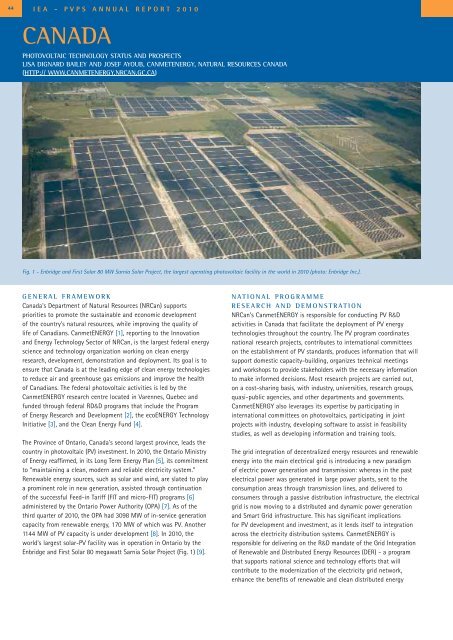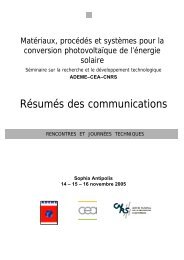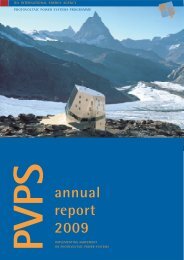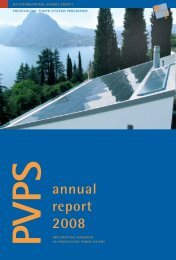Annual Report 2010 - IEA Photovoltaic Power Systems Programme
Annual Report 2010 - IEA Photovoltaic Power Systems Programme
Annual Report 2010 - IEA Photovoltaic Power Systems Programme
You also want an ePaper? Increase the reach of your titles
YUMPU automatically turns print PDFs into web optimized ePapers that Google loves.
44<br />
<strong>IEA</strong> - PVPS ANNUAL REPORT <strong>2010</strong><br />
CANADA<br />
PHOTOVOLTAIC TECHNOLOGY STATUS AND PROSPECTS<br />
LISA DIGNARD BAILEY AND JOSEF AYOUB, CANMETENERGY, NATURAL RESOURCES CANADA<br />
(HTTP:// WWW.CANMETENERGY.NRCAN.GC.CA)<br />
Fig. 1 - Enbridge and First Solar 80 MW Sarnia Solar Project, the largest operating photovoltaic facility in the world in <strong>2010</strong> (photo: Enbridge Inc.).<br />
GENERAL FRAMEWORK<br />
Canada's Department of Natural Resources (NRCan) supports<br />
priorities to promote the sustainable and economic development<br />
of the country's natural resources, while improving the quality of<br />
life of Canadians. CanmetENERGY [1], reporting to the Innovation<br />
and Energy Technology Sector of NRCan, is the largest federal energy<br />
science and technology organization working on clean energy<br />
research, development, demonstration and deployment. Its goal is to<br />
ensure that Canada is at the leading edge of clean energy technologies<br />
to reduce air and greenhouse gas emissions and improve the health<br />
of Canadians. The federal photovoltaic activities is led by the<br />
CanmetENERGY research centre located in Varennes, Quebec and<br />
funded through federal RD&D programs that include the Program<br />
of Energy Research and Development [2], the ecoENERGY Technology<br />
Initiative [3], and the Clean Energy Fund [4].<br />
The Province of Ontario, Canada's second largest province, leads the<br />
country in photovoltaic (PV) investment. In <strong>2010</strong>, the Ontario Ministry<br />
of Energy reaffirmed, in its Long Term Energy Plan [5], its commitment<br />
to “maintaining a clean, modern and reliable electricity system.”<br />
Renewable energy sources, such as solar and wind, are slated to play<br />
a prominent role in new generation, assisted through continuation<br />
of the successful Feed-in Tariff (FIT and micro-FIT) programs [6]<br />
administered by the Ontario <strong>Power</strong> Authority (OPA) [7]. As of the<br />
third quarter of <strong>2010</strong>, the OPA had 3098 MW of in-service generation<br />
capacity from renewable energy, 170 MW of which was PV. Another<br />
1144 MW of PV capacity is under development [8]. In <strong>2010</strong>, the<br />
world's largest solar-PV facility was in operation in Ontario by the<br />
Enbridge and First Solar 80 megawatt Sarnia Solar Project (Fig. 1) [9].<br />
NATIONAL PROGRAMME<br />
RESEARCH AND DEMONSTRATION<br />
NRCan's CanmetENERGY is responsible for conducting PV R&D<br />
activities in Canada that facilitate the deployment of PV energy<br />
technologies throughout the country. The PV program coordinates<br />
national research projects, contributes to international committees<br />
on the establishment of PV standards, produces information that will<br />
support domestic capacity-building, organizes technical meetings<br />
and workshops to provide stakeholders with the necessary information<br />
to make informed decisions. Most research projects are carried out,<br />
on a cost-sharing basis, with industry, universities, research groups,<br />
quasi-public agencies, and other departments and governments.<br />
CanmetENERGY also leverages its expertise by participating in<br />
international committees on photovoltaics, participating in joint<br />
projects with industry, developing software to assist in feasibility<br />
studies, as well as developing information and training tools.<br />
The grid integration of decentralized energy resources and renewable<br />
energy into the main electrical grid is introducing a new paradigm<br />
of electric power generation and transmission: whereas in the past<br />
electrical power was generated in large power plants, sent to the<br />
consumption areas through transmission lines, and delivered to<br />
consumers through a passive distribution infrastructure, the electrical<br />
grid is now moving to a distributed and dynamic power generation<br />
and Smart Grid infrastructure. This has significant implications<br />
for PV development and investment, as it lends itself to integration<br />
across the electricity distribution systems. CanmetENERGY is<br />
responsible for delivering on the R&D mandate of the Grid Integration<br />
of Renewable and Distributed Energy Resources (DER) - a program<br />
that supports national science and technology efforts that will<br />
contribute to the modernization of the electricity grid network,<br />
enhance the benefits of renewable and clean distributed energy






